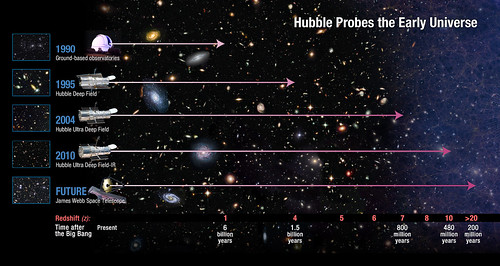Awesomeness Round-up – 1/31/11
- By Sara Mitchell
- January 31, 2011
- Comments Off on Awesomeness Round-up – 1/31/11
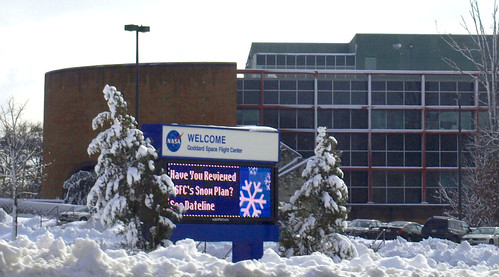
Credit: NASA/GSFC/Debbie Mccallum
I know that I kicked off last week’s round-up with a snow picture, but look! We got another six inches! Here’s the real NASA connection, though… imagery of the storm from the MODIS instrument, aboard the Terra satellite.
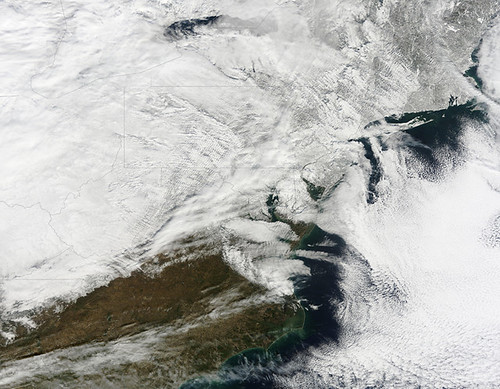
Credit: NASA Goddard/MODIS Rapid Response Team
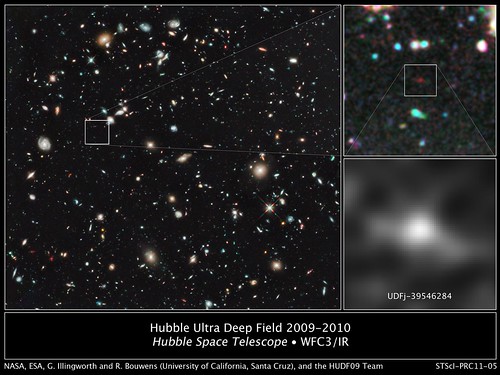
Credit: NASA, ESA, G. Illingworth (University of California, Santa Cruz), R. Bouwens (University of California, Santa Cruz, and Leiden University), and the HUDF09 Team
Hubble made big news last week with the release of this infrared ultra-deep–field exposure of the farthest and one of the very earliest galaxies ever seen in the universe. It’s just a reddish blob in the image, but this galaxy is 13.2 billion light-years away and the most distant galaxy we’ve ever seen.
This diagram shows how we’ve been able to look farther and farther out into space, thought the development of more advanced technology and projects to study deep space. The Hubble Deep Field observations are pretty awe-inspiring – for each one, the satellite was pointed at a seemingly empty patch of the night sky, and a long exposure revealed an overwhelming number of distant galaxies too faint for previous satellites to see. Each time, Hubble has looked even deeper into space… and the James Webb Space Telescope will be able to see even farther! Check out this video, which provides some context for the location and distance of this galaxy:
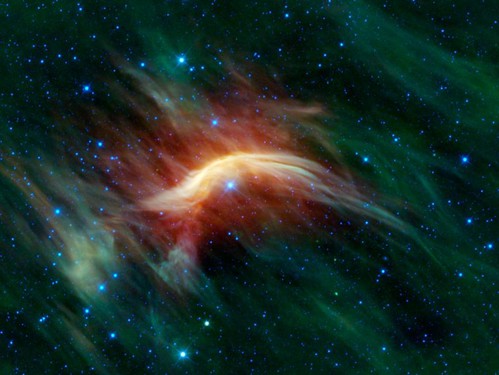
Image credit: NASA/JPL-Caltech/UCLA
WISE captured this spectacular image of “runaway” star Zeta Ophiuchi and its striking bow shock. The star once orbited a larger companion star, which exploded in a supernova and sent Zeta Ophiuchi zinging through space at 54,000 miles per hour. It’s pushing a wave of gas and dust out of its way, which can’t be see in a visible light image, but WISE’s infrared eyes saw it!
We’re looking forward to hearing about new planetary discoveries that are to be announced in a news briefing this Wednesday with collaborators from the Kepler mission. This will follow a scheduled data release on Tuesday. We know that they’ll discuss the planet candidates found over a several-month period… but the details of those planets could be pretty interesting! I suspect it’ll make it into next week’s round-up.
Two new videos from our friends who stare at the Sun for a living* came out last week. SDO captured an intense double eruption. STEREO released a teaser video for an upcoming press conference next week, where they will release the first-ever images of the entire Sun. Our nearest star has kept NASA busy!
*They do this safely, through satellite images, because actually staring at the Sun with your eyes is a bad idea. This concludes today’s obligatory public service announcement about solar viewing safety.
And finally, because I couldn’t resist name-dropping Optimus Prime one more time, here’s a short (made by Goddard’s multimedia wizards in the Scientific Visualization Studio) reminding you to vote in the video contest! I have never seen Transformers walking around in the integration and test facilities, but perhaps I’ve just visited on an off day.


